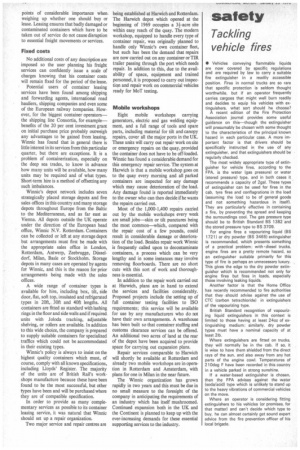safety
Page 48

If you've noticed an error in this article please click here to report it so we can fix it.
Tackling vehicle fires
• Vehicles conveying flammable liquids are now covered by specific regulations and are required by law to carry a suitable fire extinguisher in a readily accessible position. Fires in normal trucks are so rare that specific protection is seldom thought worthwhile, but if an operator frequently carries cargoes that might well burn readily and decides to equip his vehicles with extinguishers. what sort should he choose?
A recent edition of the Fire Protection Association journal provides some useful guidance on this—though the extinguisher will presumably be chosen with some thought to the characteristics of the principal known hazard in each particular case. A more important factor is that drivers should be specifically instructed in the use of any extinguisher. and that extinguishers should be • regularly checked.
The most widely appropriate type of extinguisher for vehicle fires, according to the FPA, is the water (gas pressure) or water (stored pressure) type, and in both cases it recommends a capacity of 2gal. These types of extinguisher can be used for fires in the cab, tyre fires and conflagrations in the load (assuming the load to be of general goods and not something hazardous in itself). They are particularly effective in containing a fire, by preventing the spread and keeping the surroundings cool. The gas pressure type should be to British Standard BS 1382 and the stored pressure type to BS 3709.
For engine fires a vapourizing liquid (BS 1721) or dry powder (BS 3485} extinguisher is recommended, which presents something of a practical problem; with 'diesel trucks, engine fires are a pretty remote hazard, so an extinguisher suitable primarily for this type of fire is perhaps an unnecessary luxury. This gives the edge to the dry powder extinguisher which is recommended not only for engine fires but fires in loads, especially those involving leaking liquids.
Another factor is that the Home Office has recently recommended to fire authorities that they •should advise against the use of CTC (carbon tetrachloride) in extinguishers of the vapourizing type.
British Standard recognition of vapourizing liquid extinguishers in this context is limited to those having at least 24oz of extinguishing medium; similarly, dry powder types must have a nominal capacity of at least 21b.
Where extinguishers are fitted on trucks, they will normally be in the cab. If so, it is wise to have them shielded from the direct rays of the sun, and also away from any hot parts of the engine cowl. Temperatures of 210deg F have been recorded in this country in a vehicle parked in strong sunshine.
If a water-based extinguisher is chosen, then the FPA advises against the water (soda/acid) type which is unlikely to stand up to the heavy vibrations of commercial vehicles on the move.
Where an operator is considering fitting extinguishers to his vehicles (or premises, for that matter) and can't decide which type to buy, he can almost certainly get sound expert advice from the fire prevention officer of his local brigade.








































































































